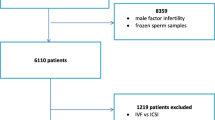Abstract
Purpose
The purpose of this study was to evaluate the significance of converting an IVF stimulation cycle with poor ovarian response to an IUI cycle.
Methods
Between January and December 2007, 47 cycles of IVF conversion to IUI were retrospectively studied in 44 infertile women who had a low response to ovarian hyperstimulation for IVF. Patients’ characteristics, ovarian stimulation, and ovarian response and outcome were collected and compared with those of 41 women undergoing ovum pickup for IVF with poor ovarian response (n = 44 cycles) in the same period.
Results
Women in the conversion group had slightly lower ovarian reserve, shorter stimulation with higher rFSH doses, lower peak estradiol and fewer mature follicles than in the IVF group. Pregnancy rates were comparable in both groups, though clinical pregnancy rate tended to be higher in the conversion group than in the IVF group.
Conclusions
Thus, pregnancy rate in the conversion group compares favourably with IVF outcome in such circumstances. This means that IVF conversion to IUI in poor responders who are suitable for IUI is a valuable alternative that should be considered in their management.

Similar content being viewed by others
References
Ubaldi FM, Rienzi L, Ferrero S et al (2005) Management of poor responders in IVF. Reprod Biomed Online 10:235–246
Rowe T (2006) Fertility and a woman’s age. J Reprod Med 51:157–163
Pastor CL, Vanderhoof VH, Lim LC et al (2005) Pilot study investigating the age-related decline in ovarian function of regularly menstruating normal women. Fertil Steril 84:1462–1469
Broekmans FJ, Kwee J, Hendriks DJ et al (2006) A systematic review of tests predicting ovarian reserve and IVF outcome. Hum Reprod Update 12:685–718
Tarlatzis BC, Zepiridis L, Grimbizis G et al (2003) Clinical management of low ovarian response to stimulation for IVF: a systematic review. Hum Reprod Update 9:61–76
Loutradis D, Vomvolaki E, Drakakis P (2008) Poor responder protocols for in vitro fertilization: options and results. Curr Opin Obstet Gynecol 20:374–378
Surrey ES (2000) Schoolcraft WB Evaluating strategies for improving ovarian response of the poor responder undergoing assisted reproductive techniques. Fertil Steril 73:667–676
Ulug U, Ben-Shlomo I, Turan E et al (2003) Conception rates following assisted reproduction in poor responder patients: a retrospective study in 300 consecutive cycles. Reprod Biomed Online 6:439–443
van Weert JM, van den Broek J, van der Steeg JW et al (2007) Patients’ preferences for intrauterine insemination or in vitro fertilization. Reprod Biomed Online 15:422–427
van der Gaast MH, Eijkemans MJ, van der Net JB et al (2006) Optimum number of oocytes for a successful first IVF treatment cycle. Reprod Biomed Online 13:476–480
Kaplan PF, Patel M, Austin DJ, Freund R (2002) Assessing the risk of multiple gestation in gonadotropin intrauterine insemination cycles. Am J Obstet Gynecol 186:1244–1247
Singer T, Barad DH, Weghofer A, Gleicher N (2009) Correlation of antimüllerian hormone and baseline follicle-stimulating hormone levels. Fertil Steril 91:2616–2619
Fanchin R, Schonäuer LM, Righini C et al (2003) Serum anti-Müllerian hormone is more strongly related to ovarian follicular status than serum inhibin B, estradiol, FSH and LH on day 3. Hum Reprod 18:323–327
Wainer R, Albert M, Dorion A et al (2004) Influence of the number of motile spermatozoa inseminated and of their morphology on the success of intrauterine insemination. Hum Reprod 19:2060–2065
Ombelet W, Deblaere K, Bosmans E et al (2003) Semen quality and intrauterine insemination. Reprod Biomed Online 7:485–492
Abusheikha N, Lass A, Burnley A et al (2001) In vitro fertilization cycles converted to intrauterine insemination because of poor follicular response have low success rates. Fertil Steril 75:634–635
Matorras R, Corcóstegui B, Mendoza R et al (2003) Converting an IVF cycle to IUI in low responders with at least 2 follicles. J Reprod Med 48:789–791
Kaplan PF, Katz SL, Thompson AK et al (2002) Cycle fecundity in controlled ovarian hyperstimulation and intrauterine insemination. Influence of the number of mature follicles at hCG administration. J Reprod Med 47:535–539
Wood S, Rahim R, Searle T, Sajjad Y, Troup S, Lewis-Jones I, Kingsland C (2003) Optimal treatment for poor responders to ovarian stimulation: does in vitro insemination offer any advantages to intrauterine insemination? Hum Fertil (Camb) 6(1):13–18
Saldeen P, Källen K, Sundström P (2007) The probability of successful IVF outcome after poor ovarian response. Acta Obstet Gynecol Scand 86:457–461
Kailasam C, Keay SD, Wilson P et al (2004) Defining poor ovarian response during IVF cycles, in women aged <40 years, and its relationship with treatment outcome. Hum Reprod 19:1544–1547
Baka S, Makrakis E, Tzanakaki D, Konidaris S, Hassiakos D, Moustakarias T, Creatsas G (2006) Poor responders in IVF: cancellation of a first cycle is not predictive of a subsequent failure. Ann N Y Acad Sci 1092:418–425
Franco JG Jr, Baruffi RL, Mauri AL et al (2006) GnRH agonist versus GnRH antagonist in poor ovarian responders: a meta-analysis. Reprod Biomed Online 13:618–627
Shanbhag S, Aucott L, Bhattacharya S et al (2007) Interventions for ‘poor responders’ to controlled ovarian hyperstimulation (COH) in in vitro fertilisation (IVF). Cochrane Database Syst Rev (1):CD004379
Ubaldi F, Rienzi L, Baroni E et al (2007) Hopes and facts about mild ovarian stimulation. Reprod Biomed Online 14:675–681
Kumbak B, Ulug U, Erzik B et al (2009) Early clinical pregnancy loss rate in poor responder patients does not change compared to age-matched normoresponders. Fertil Steril 91:106–109
Patrizio P, Bianchi V, Lalioti MD et al (2007) High rate of biological loss in assisted reproduction: it is in the seed, not in the soil. Reprod Biomed Online 14:92–95
Hourvitz A, Lerner-Geva L, Elizur SE et al (2006) Role of embryo quality in predicting early pregnancy loss following assisted reproductive technology. Reprod Biomed Online 13:504–509
Conflict of interest statement
All authors declare that they have no conflict of interest.
Author information
Authors and Affiliations
Corresponding author
Rights and permissions
About this article
Cite this article
Freour, T., Dubourdieu, S., Mirallie, S. et al. IVF conversion to IUI in poor responders: an observational study. Arch Gynecol Obstet 282, 445–449 (2010). https://doi.org/10.1007/s00404-010-1515-0
Received:
Accepted:
Published:
Issue Date:
DOI: https://doi.org/10.1007/s00404-010-1515-0




